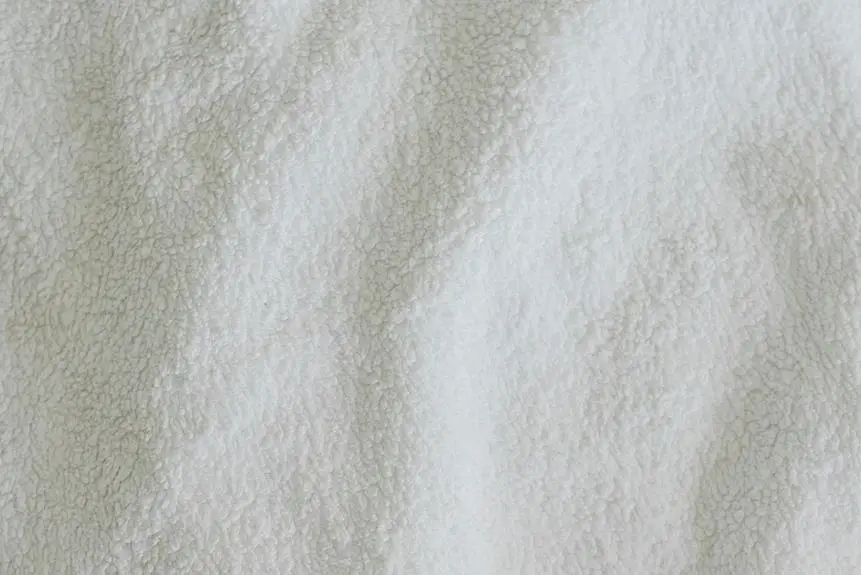You might think that using fabric softener on your towels is a simple way to keep them feeling plush and comfortable. However, it's essential to understand how this seemingly harmless addition can impact their absorbency. While you enjoy the softness, you could be unknowingly creating a barrier that prevents effective moisture absorption. The long-term effects might surprise you, especially if you're relying on your towels for optimal performance. So, what alternatives exist to maintain that comforting feel without sacrificing functionality?
Table of Contents
Key Takeaways
- Fabric softeners coat towel fibers, reducing their ability to absorb moisture effectively due to a barrier created on the fibers.
- The application of fabric softeners can lead to a decrease in towel absorbency, making them feel damp after use.
- Long-term use of fabric softeners compromises towel performance by creating buildup that hinders moisture capture and drying efficiency.
- Alternatives like vinegar or baking soda can maintain towel softness without diminishing absorbency, unlike traditional fabric softeners.
Understanding Towel Absorbency
Towel absorbency refers to how well a towel can soak up moisture, which is crucial for its effectiveness in drying. When you step out of the shower, you want a towel that quickly absorbs water, leaving your skin dry and comfortable. The key factors influencing absorbency include the type of fabric, the towel's weight, and its construction.
Cotton is one of the most popular materials for towels due to its high absorbency. When you choose a towel, consider its GSM (grams per square meter) rating; higher GSM usually means better absorbency. A towel with a lower GSM might dry faster but won't soak up as much water. You'll want to balance absorbency and drying time based on your needs.
The way a towel is woven also plays a significant role. Loops in the fabric create more surface area, allowing for better moisture capture. When you pick a towel, keep in mind that a plush, looped texture typically indicates superior absorbency.
Understanding these factors will help you choose the perfect towel that meets your drying needs while ensuring it performs effectively over time.
How Fabric Softener Works
Fabric softener works by coating the fibers of your laundry, which can affect their texture and absorbency. When you add fabric softener during the rinse cycle, it releases positively charged particles that bond to the negatively charged fibers of your towels, altering their surface properties.
Here's how it typically happens:
- Coating: The softener forms a thin layer around the fibers, making them feel smoother and softer to the touch.
- Separation: This coating helps reduce friction between the fibers, which can lead to a fluffier feel but may also hinder how well they can absorb water.
- Static Reduction: Fabric softeners can help minimize static cling, keeping your laundry looking neat and tidy.
- Fragrance: Many fabric softeners add a pleasant scent to your laundry, giving it that fresh, clean smell you love.
While you enjoy the softness and fragrance, it's essential to remember that this coating can impact how effectively towels soak up water. Understanding this process can help you make informed choices for your laundry routine.
Effects on Towel Performance
Using fabric softener can significantly reduce your towels' ability to absorb water effectively.
When you wash your towels with fabric softener, a thin layer of chemicals coats the fibers. This coating can create a barrier that prevents moisture from being absorbed as it should. As a result, your towels may feel softer, but they won't perform as they should when it comes to drying your skin after a shower.
You might notice that your towels take longer to dry you off, or they might leave you feeling damp. This isn't just inconvenient; it can lead to a less satisfying drying experience. If your towels aren't absorbing water well, you may end up using more towels than necessary, leading to increased laundry loads.
Additionally, over time, the build-up of fabric softener can compromise the structural integrity of the towel fibers, making them less durable. Instead of providing that plush feel you love, they can become stiff and less effective.
If you want your towels to perform their best, it might be worth considering skipping the fabric softener altogether and opting for alternatives that won't hinder absorbency.
The Science of Absorbency
When it comes to towel absorbency, understanding the science behind it is crucial.
You'll discover how absorbency mechanisms work and how fabric softener chemistry can impact your towels' ability to soak up water.
Let's break down these concepts to see how they affect your everyday use.
Absorbency Mechanism Explained
Towels absorb moisture through a combination of their fiber structure and surface tension, which work together to draw water into their material. Understanding how this happens can help you choose the best towels for your needs.
Fiber Structure: Towels are typically made from cotton, which has a unique looped design. This structure creates additional surface area, allowing more water to be captured.
Capillary Action: Water molecules are attracted to the fibers. This attraction, combined with the narrow spaces between the fibers, enables water to climb up into the towel, much like how liquid rises in a thin straw.
Surface Tension: The cohesive forces among water molecules create a barrier that helps them cling to the fibers. This mechanism allows towels to hold onto moisture instead of letting it drip away.
Density: The density of the fibers also plays a crucial role. A denser towel can trap more air pockets, enhancing its ability to absorb and retain water.
Fabric Softener Chemistry Effects
Fabric softeners coat towel fibers with a thin layer of lubrication, which can significantly reduce their absorbency by interfering with the natural capillary action. When you wash towels with fabric softener, the chemicals—typically cationic surfactants—adhere to the fibers. This coating creates a barrier that hampers water's ability to penetrate the fibers and be absorbed.
In essence, the surfactants modify the surface tension, making it harder for water to move into the towel. Instead of soaking up moisture, the towel may repel it, resulting in a less effective drying experience. You might notice that towels treated with fabric softeners feel softer and smell fresher, but this comes at the cost of their absorbency.
Moreover, the long-term use of fabric softener can lead to a buildup on the fibers, further diminishing their performance. Even though you may prefer the feel and fragrance, if you want your towels to remain highly absorbent, consider skipping the fabric softener altogether.
Opt for alternatives like vinegar, which can help maintain softness without compromising absorbency. Understanding this chemistry helps you make informed choices about your laundry routine.
Alternatives to Fabric Softeners
You can easily achieve soft, absorbent towels without using traditional fabric softeners by opting for natural alternatives. These options not only enhance the softness of your towels but also maintain their absorbency.
Here are four effective alternatives you can try:
- White Vinegar: Add half a cup of white vinegar to your rinse cycle. It breaks down detergent residues, leaving towels fluffy and odor-free.
- Baking Soda: Mix a quarter cup of baking soda into your wash. It helps to soften fabrics and neutralizes any unpleasant smells.
- Essential Oils: For a pleasant fragrance, add a few drops of your favorite essential oil to the wash. This gives your towels a fresh scent without compromising their absorbency.
- Wool Dryer Balls: Toss a few wool dryer balls into the dryer with your towels. They help to separate fabrics, allowing hot air to circulate better, which results in faster drying and softer towels.
Tips for Maintaining Absorbency
To keep your towels absorbent, you should wash them with vinegar instead of fabric softener.
Using proper drying techniques also plays a crucial role in maintaining their fluffiness and absorbency.
Wash With Vinegar
Washing towels with vinegar helps restore their absorbency by breaking down detergent residue and mineral buildup. If your towels have lost their fluffiness and ability to soak up water, vinegar can be your go-to solution. Here's how to use it effectively:
Choose the Right Vinegar: Use white distilled vinegar for the best results. It's cost-effective and won't leave a lingering scent.
Add Vinegar to the Wash: Pour 1 cup of vinegar into the fabric softener dispenser of your washing machine. This ensures it's added during the rinse cycle, which is crucial for breaking down residues.
Wash on a Hot Cycle: Select a hot water cycle for the wash. Heat helps dissolve any remaining detergent and mineral deposits, enhancing the effect of the vinegar.
Rinse Thoroughly: After washing, run an additional rinse cycle if necessary. This step ensures all vinegar and residues are completely washed out, leaving your towels fresh and absorbent.
Skip Fabric Softener
Vinegar can help restore towel absorbency, but skipping fabric softener altogether is another effective way to maintain that fluffy, water-absorbing quality. Fabric softeners coat the fibers, reducing their ability to soak up moisture. By avoiding softeners, you allow your towels to stay absorbent and soft naturally.
Here are some benefits of skipping fabric softener:
| Benefit | Description | Why It Matters |
|---|---|---|
| Improved Absorbency | Towels can absorb water more effectively. | You get drier faster after a shower. |
| Longer Lifespan | Towels last longer without chemical build-up. | Save money in the long run. |
| Eco-Friendly | Avoiding synthetic chemicals reduces environmental impact. | Good for the planet. |
| Natural Softness | Towels retain their natural texture and fluffiness. | Enjoy a cozy feel without additives. |
| Cost-Effective | You save money by not purchasing fabric softeners. | Budget-friendly towel care solution. |
Proper Drying Techniques
Proper drying techniques play a crucial role in maintaining your towels' absorbency and softness. If you want your towels to remain fluffy and effective, follow these essential tips:
- Use Low Heat: High heat can damage towel fibers, making them less absorbent. Opt for a low-heat setting to preserve their quality.
- Avoid Overdrying: Take your towels out while they're still slightly damp. This helps maintain their softness and prevents them from becoming stiff.
- Shake Them Out: After drying, give your towels a good shake. This helps to separate the fibers, allowing air to circulate and enhancing their fluffiness.
- Store Properly: Fold and store your towels in a dry, well-ventilated space. Avoid cramming them in tight spots, as this can flatten the fibers and reduce absorbency.
Weighing Softness Vs. Functionality
Choosing between the luxurious softness of fabric softener and the essential absorbency of towels can be a tricky balancing act. You want your towels to feel plush against your skin, but you also need them to dry you off efficiently after a shower.
When you use fabric softener, you're enhancing that soft, velvety texture, but you might be sacrificing the towel's ability to soak up water.
It's important to consider how you'll use your towels. If you primarily want them for drying off, you might opt to skip the fabric softener. Instead, try using dryer balls or vinegar to maintain some softness without compromising absorbency. Alternatively, if you're looking for towels to double as luxurious home décor, a bit of fabric softener could make sense.
Ultimately, the choice boils down to your personal preference. You can experiment with different products and drying methods to find a balance that suits your needs. By weighing the importance of softness against functionality, you can make an informed decision that keeps your towels feeling great while still performing their primary job effectively.
Frequently Asked Questions
Can Fabric Softener Cause Towels to Smell Differently?
Yes, fabric softener can cause towels to smell differently. It often leaves a scent that might mask odors or, in some cases, create an unpleasant smell due to residue buildup. You might want to rinse your towels thoroughly.
How Often Should I Wash Towels to Maintain Absorbency?
Wash your towels every three to four uses to maintain their absorbency. If they start feeling less absorbent, consider washing them more frequently. Always dry them completely to prevent mildew and keep them fresh.
Are There Specific Brands of Fabric Softeners to Avoid?
You should avoid fabric softeners that contain heavy oils or silicone. Brands with these ingredients can leave residues on fabrics, making them less effective at absorbing moisture and affecting their overall performance. Check labels before purchasing.
Does the Water Temperature Affect Fabric Softener's Impact on Towels?
Yes, water temperature affects how fabric softener interacts with towels. Hot water can dissolve softener better, but it might also reduce towel absorbency. Experiment with different temperatures to find what works best for your towels.
How Does Drying Method Influence Towel Absorbency With Fabric Softener?
Drying method significantly affects towel absorbency. If you air dry towels, they retain moisture better. However, using a dryer can make them fluffier but may reduce absorbency, especially when fabric softener's involved.
- Everything You Need to Know About Nonwoven Geotextiles - July 11, 2025
- A Complete Breakdown of SMS (Spunbond-Meltblown-Spunbond) Fabric - July 11, 2025
- The Top 5 Uses for Nonwoven Fabric You Didn’t Know About - July 11, 2025




